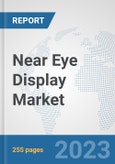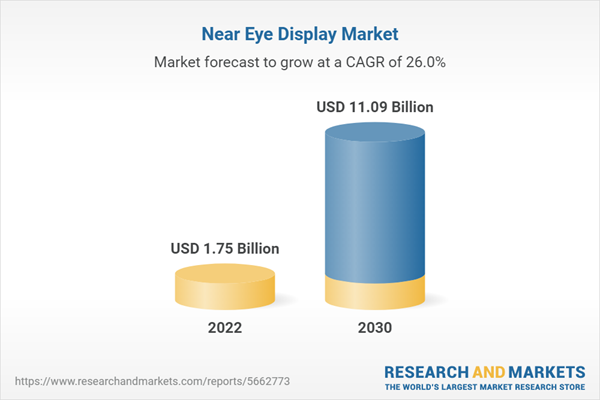The report on the global near eye display market provides qualitative and quantitative analysis for the period from 2021-2030. The revenue generated by the near eye display market was USD 1.75 billion in 2022 and is expected to reach USD 11.09 billion in 2030 and is expected to grow with a CAGR of 25.97% over the forecast period 2023-2030. The study on near eye display market covers the analysis of the leading geographies such as North America, Europe, Asia Pacific, and RoW for the period of 2021-2030.
Near‐eye displays are an enabling vessel for VR/AR applications, which must tackle many challenges related to ergonomics, comfort, visual quality, and natural interaction. AR and VR demand is rising, and this is driving the growth of the near-eye display market. Near-eye displays are essential components of AR and VR devices, as they allow users to see digital images and objects superimposed on the real world or in a fully immersive virtual environment. Additionally, heightened military expenditures drive a surge in the demand for the near-eye display market. For instance, in 2022, India ranked as the world's third-largest military spender, with expenditures of USD 76.6 billion, comprising 3.7% of global military spending, following only the United States and China. These displays offer valuable benefits to military personnel, empowering them with advanced situational awareness, superior target acquisition capabilities, and heightened combat efficiency. Similarly, in aerospace, these devices improve situational awareness and enhance safety and efficiency in aviation and space exploration. Hence, as investment in the aerospace and defense industries rises, the demand for the near-eye display market is also likely to propel.
The OLED segment of the near-eye display market holds the largest market share. In recent years, manufacturers such as Sony Semiconductor Solutions have made substantial advancements in optimizing OLED microdisplays specifically for Augmented Reality (AR) applications, where characteristics like high brightness, excellent contrast, and low power consumption are crucial. While OLED displays have been commonly employed in various non-AR applications for some time, their significantly improved brightness now positions them as a viable alternative to DLP and LCoS technology in the AR field. OLED microdisplays provide exceptionally high resolution and brightness within compact display dimensions. Owing to their efficient power usage, small form factor, and simplified control electronics, OLED microdisplays are exceptionally well-suited for compact, energy-efficient embedded systems. In terms of response time, traditional OLED displays operate in the microsecond range, making them more than 1,000 times faster than LCoS displays, in broad terms.
The Asia Pacific region is poised to hold the largest market share in the global near-eye display market due to several key factors. Firstly, the region's immense population and expanding middle class create a substantial consumer base for products like Augmented Reality (AR) and Virtual Reality (VR) devices, which heavily rely on near-eye displays. Secondly, the presence of major tech giants and innovative startups in countries like China, Japan, and South Korea ensures a steady stream of cutting-edge research and development in this field. Furthermore, the Asia Pacific region benefits from robust manufacturing capabilities, making it a hub to produce near-eye display components, resulting in cost-effective solutions. Additionally, government support and investments in emerging technologies, along with increasing consumer awareness and adoption, further bolster the region's position in the global near-eye display market. These factors collectively position Asia Pacific as a powerhouse in this industry, with the largest market share.
1. Key Opinion Leaders
2. Internal and External subject matter experts
3. Professionals and participants from the industry
2. Product/brand/marketing managers
3. CXO level executives
4. Regional/zonal/ country managers
5. Vice President level executives.
2. Government/institutional publications
3. Trade and associations journals
4. Databases such as WTO, OECD, World Bank, and among others.
5. Websites and publications by research agencies
2. Complete coverage of all the segments in the near eye display market to analyze the trends, developments in the global market and forecast of market size up to 2030.
3. Comprehensive analysis of the companies operating in the global near eye display market. The company profile includes analysis of product portfolio, revenue, SWOT analysis and latest developments of the company.
4. Growth Matrix presents an analysis of the product segments and geographies that market players should focus to invest, consolidate, expand and/or diversify.
Near‐eye displays are an enabling vessel for VR/AR applications, which must tackle many challenges related to ergonomics, comfort, visual quality, and natural interaction. AR and VR demand is rising, and this is driving the growth of the near-eye display market. Near-eye displays are essential components of AR and VR devices, as they allow users to see digital images and objects superimposed on the real world or in a fully immersive virtual environment. Additionally, heightened military expenditures drive a surge in the demand for the near-eye display market. For instance, in 2022, India ranked as the world's third-largest military spender, with expenditures of USD 76.6 billion, comprising 3.7% of global military spending, following only the United States and China. These displays offer valuable benefits to military personnel, empowering them with advanced situational awareness, superior target acquisition capabilities, and heightened combat efficiency. Similarly, in aerospace, these devices improve situational awareness and enhance safety and efficiency in aviation and space exploration. Hence, as investment in the aerospace and defense industries rises, the demand for the near-eye display market is also likely to propel.
The OLED segment of the near-eye display market holds the largest market share. In recent years, manufacturers such as Sony Semiconductor Solutions have made substantial advancements in optimizing OLED microdisplays specifically for Augmented Reality (AR) applications, where characteristics like high brightness, excellent contrast, and low power consumption are crucial. While OLED displays have been commonly employed in various non-AR applications for some time, their significantly improved brightness now positions them as a viable alternative to DLP and LCoS technology in the AR field. OLED microdisplays provide exceptionally high resolution and brightness within compact display dimensions. Owing to their efficient power usage, small form factor, and simplified control electronics, OLED microdisplays are exceptionally well-suited for compact, energy-efficient embedded systems. In terms of response time, traditional OLED displays operate in the microsecond range, making them more than 1,000 times faster than LCoS displays, in broad terms.
The Asia Pacific region is poised to hold the largest market share in the global near-eye display market due to several key factors. Firstly, the region's immense population and expanding middle class create a substantial consumer base for products like Augmented Reality (AR) and Virtual Reality (VR) devices, which heavily rely on near-eye displays. Secondly, the presence of major tech giants and innovative startups in countries like China, Japan, and South Korea ensures a steady stream of cutting-edge research and development in this field. Furthermore, the Asia Pacific region benefits from robust manufacturing capabilities, making it a hub to produce near-eye display components, resulting in cost-effective solutions. Additionally, government support and investments in emerging technologies, along with increasing consumer awareness and adoption, further bolster the region's position in the global near-eye display market. These factors collectively position Asia Pacific as a powerhouse in this industry, with the largest market share.
Report Findings
1) Drivers
- With the rise in the adoption of AR and VR technology, the demand for near-eye displays is propelled.
- Rising applications in the aerospace and defense sectors will boost market growth.
2) Restraints
- The health effects of near-eye display eyes such as visual distortions are expected to hamper the growth of the market.
3) Opportunities
- Growing investments in R&D of new innovative products are expected to create ample growth opportunities during the forecast period.
Research Methodology
A) Primary Research
The primary research involves extensive interviews and analysis of the opinions provided by the primary respondents. The primary research starts with identifying and approaching the primary respondents, the primary respondents are approached include1. Key Opinion Leaders
2. Internal and External subject matter experts
3. Professionals and participants from the industry
The primary research respondents typically include
1. Executives working with leading companies in the market under review2. Product/brand/marketing managers
3. CXO level executives
4. Regional/zonal/ country managers
5. Vice President level executives.
B) Secondary Research
Secondary research involves extensive exploring through the secondary sources of information available in both the public domain and paid sources. Each research study is based on over 500 hours of secondary research accompanied by primary research. The information obtained through the secondary sources is validated through the crosscheck on various data sources.The secondary sources of the data typically include
1. Company reports and publications2. Government/institutional publications
3. Trade and associations journals
4. Databases such as WTO, OECD, World Bank, and among others.
5. Websites and publications by research agencies
Segment Covered
The global near eye display market is segmented on the basis of technology, device type, and end user vertical.The Global Near Eye Display Market by Technology
- TFT LCD
- OLEDs
- LCOs
- Micro-LED
- AMOLED
- DLP
- Laser Beam Scanning
The Global Near Eye Display Market by Device Type
- AR
- VR
The Global Near Eye Display Market by End User Vertical
- Consumer
- Medical
- Aerospace & Defence
- Automotive
Company Profiles
The companies covered in the report include- TriLite Technologies GmbH
- Himax Technologies, Inc.
- Kopin Corporation
- Jade Bird Display(JBD)
- Sony Corporation
- MICROOLED Technologies
- BOE Technology Group Co., Ltd.
- SYNDIANT
- Plessey
- eMagin
What does this Report Deliver?
1. Comprehensive analysis of the global as well as regional markets of the near eye display market.2. Complete coverage of all the segments in the near eye display market to analyze the trends, developments in the global market and forecast of market size up to 2030.
3. Comprehensive analysis of the companies operating in the global near eye display market. The company profile includes analysis of product portfolio, revenue, SWOT analysis and latest developments of the company.
4. Growth Matrix presents an analysis of the product segments and geographies that market players should focus to invest, consolidate, expand and/or diversify.
This product will be delivered within 1-3 business days.
Table of Contents
Chapter 1. Preface
Chapter 2. Executive Summary
Chapter 3. Global Near Eye Display Market Overview
Chapter 5. Company Profiles and Competitive Landscape
Chapter 6. Global Near Eye Display Market by Technology
Chapter 7. Global Near Eye Display Market by Device Type
Chapter 8. Global Near Eye Display Market by End User Vertical
Chapter 9. Global Near Eye Display Market by Region 2023-2030
Executive Summary
The report on near eye display market is a comprehensive study and presentation of drivers, restraints, opportunities, demand factors, market size, forecasts, and trends in the global near eye display market over the period of 2020 to 2028. Moreover, the report is a collective presentation of primary and secondary research findings.Companies Mentioned
- TriLite Technologies GmbH
- Himax Technologies, Inc.
- Kopin Corporation
- Jade Bird Display(JBD)
- Sony Corporation
- MICROOLED Technologies
- BOE Technology Group Co., Ltd.
- SYNDIANT
- Plessey
- eMagin
Table Information
| Report Attribute | Details |
|---|---|
| No. of Pages | 255 |
| Published | May 2023 |
| Forecast Period | 2022 - 2030 |
| Estimated Market Value ( USD | $ 1.75 Billion |
| Forecasted Market Value ( USD | $ 11.09 Billion |
| Compound Annual Growth Rate | 25.9% |
| Regions Covered | Global |
| No. of Companies Mentioned | 10 |









